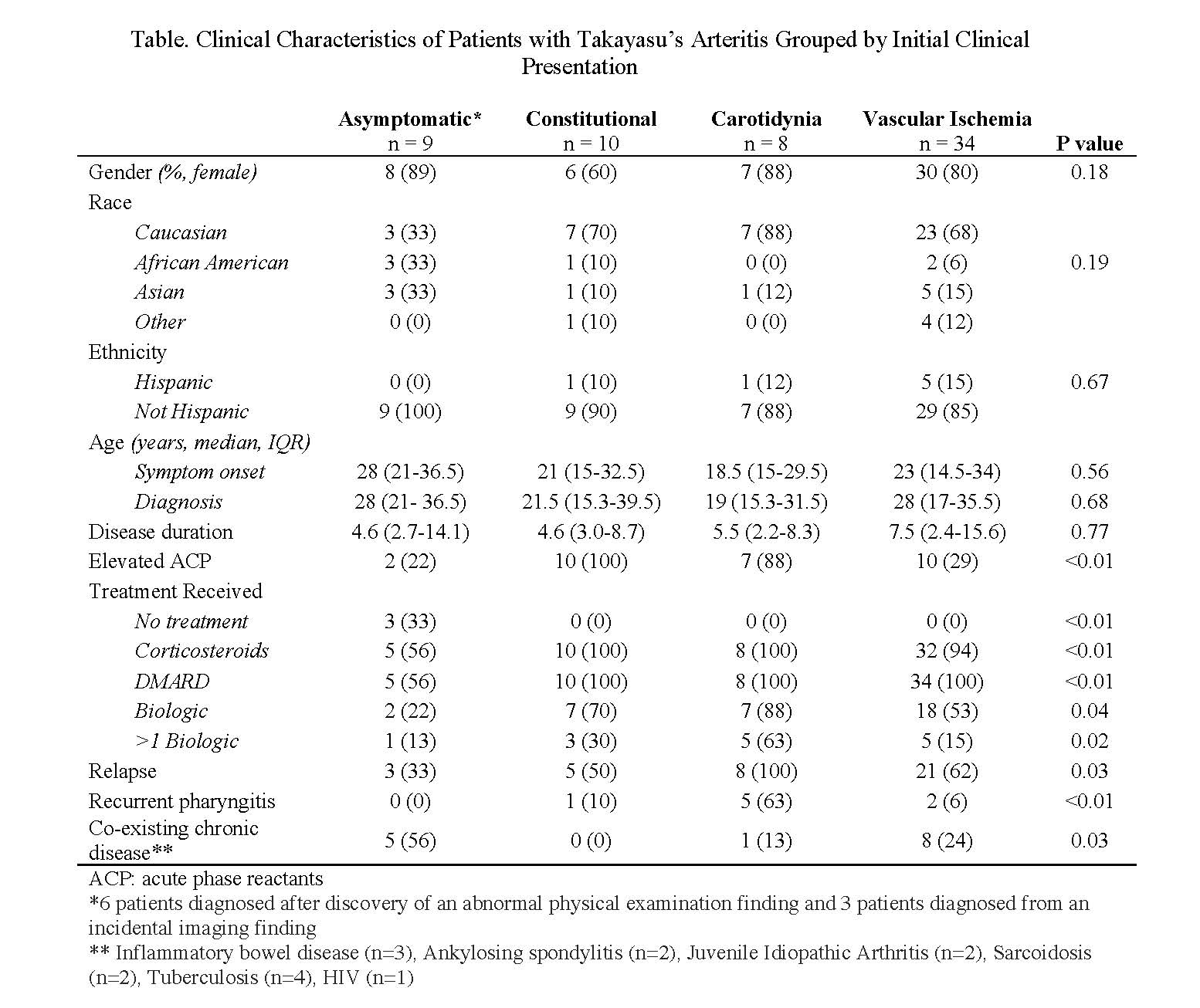Session Information
Session Type: Poster Session (Sunday)
Session Time: 9:00AM-11:00AM
Background/Purpose: The natural history of Takayasu’s arteritis (TAK) remains poorly characterized. A “triphasic” pattern of disease has been proposed where constitutional symptoms precede vascular inflammation and subsequent vascular damage. However, this pattern is often not seen, and there is wide variability in the initial features of disease, including asymptomatic patients diagnosed based on incidental findings on vascular examination or imaging. This study aimed to characterize patients with Takayasu’s arteritis based on the presenting features of disease in association with clinical outcomes.
Methods: An observational cohort of patients with TAK was prospectively recruited. All patients fulfilled the 1990 ACR Classification Criteria for TAK. Patients were divided into four categories based on initial presentation as follows: 1) asymptomatic, 2) nonspecific constitutional symptoms alone, 3) vascular inflammation (defined as carotidynia), and 4) vascular ischemia [defined as a symptom secondary to arterial damage (i.e limb claudication, stroke, etc.)]. Group status was studied in association with demographics, diagnostic delay, acute phase reactant levels, relapse rate, treatment received, a history of antecedent pharyngitis, and presence of chronic inflammatory co-morbidities. Differences among groups were assessed by chi square test and Kruskal-Wallis test as appropriate.
Results: 61 patients with TAK were studied, with a median disease duration of 6 years (Table). Most patients reported vascular symptoms as the first feature of disease. Eight patients (13%) presented with carotidynia, and 34 patients (56%) presented with an ischemic vascular event. Ten patients (16%) presented with nonspecific constitutional symptoms alone, and nine patients (15%) were asymptomatic at presentation. Initial presentation was not associated with gender, race, ethnicity, or age. Elevated acute phase reactants were most frequent in the group presenting with constitutional symptoms (100%) and carotidynia (88%) (p< 0.01). The group presenting with carotidynia had the most frequent relapses, with 100% of patients relapsing at some point in their disease course (p=0.03). This group was the most frequently refractory to treatment with corticosteroids and DMARDS; biologic therapy was required in 88% patients (p=0.04) and >1 biologic was required in 63% patients (p=0.02). Many patients in the group with nonspecific constitutional symptoms also had refractory disease with 70% patients requiring biologic therapy and 30% requiring >1 biologic. Antecedent pharyngitis was seen in five of the eight patients (63%) presenting with carotidynia (p< 0.01). Co-existing chronic inflammatory disease was most frequently seen in the patients who were asymptomatic at disease diagnosis (p=0.03).
Conclusion: There is heterogeneity in clinical presentation at time of diagnosis in TAK, and patients do not necessarily progress sequentially through multiple phases of the disease. Initial clinical presentation may dictate future disease trajectory and inform treatment response, risk for relapse, and potential causal factors.
To cite this abstract in AMA style:
Quinn K, Gribbons K, Novakovich E, Grayson P. Initial Clinical Presentation Is Associated with Outcome in Takayasu’s Arteritis [abstract]. Arthritis Rheumatol. 2019; 71 (suppl 10). https://acrabstracts.org/abstract/initial-clinical-presentation-is-associated-with-outcome-in-takayasus-arteritis/. Accessed .« Back to 2019 ACR/ARP Annual Meeting
ACR Meeting Abstracts - https://acrabstracts.org/abstract/initial-clinical-presentation-is-associated-with-outcome-in-takayasus-arteritis/

